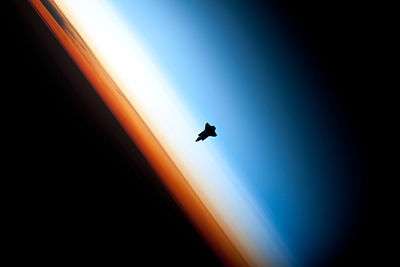Mesosphere


The mesosphere (/ˈmɛsoʊsfɪər/; from Greek mesos "middle" and sphaira "sphere") is the layer of the Earth's atmosphere that is directly above the stratosphere and directly below the mesopause. In the mesosphere, temperature decreases as the altitude increases. The upper boundary of the mesosphere is the mesopause, which can be the coldest naturally occurring place on Earth with temperatures below −143 °C (−225 °F; 130 K). The exact upper and lower boundaries of the mesosphere vary with latitude and with season, but the lower boundary of the mesosphere is usually located at heights of about 50 kilometres (160,000 ft; 31 mi) above the Earth's surface and the mesopause is usually at heights near 100 kilometres (62 mi), except at middle and high latitudes in summer where it descends to heights of about 85 kilometres (53 mi; 279,000 ft).
The stratosphere, mesosphere and lowest part of the thermosphere are collectively referred to as the "middle atmosphere", which spans heights from approximately 10 kilometres (33,000 ft; 6.2 mi) to 100 kilometres (62 mi; 330,000 ft). The mesopause, at an altitude of 80–90 km (50–56 mi), separates the mesosphere from the thermosphere—the second-outermost layer of the Earth's atmosphere. This is also around the same altitude as the turbopause, below which different chemical species are well mixed due to turbulent eddies. Above this level the atmosphere becomes non-uniform; the scale heights of different chemical species differ by their molecular masses.
Temperature
Within the mesosphere, temperature decreases with increasing height, due to decreasing solar heating and increasing cooling by CO2 radiative emission. The top of the mesosphere, called the mesopause, is the coldest part of Earth's atmosphere.[2] Temperatures in the upper mesosphere fall as low as −101 °C (172 K; −150 °F),[3] varying according to latitude and season.
Dynamic features
The main dynamic features in this region are strong zonal (East-West) winds, atmospheric tides, internal atmospheric gravity waves (commonly called "gravity waves"), and planetary waves. Most of these tides and waves start in the troposphere and lower stratosphere, and propagate to the mesosphere. In the mesosphere, gravity-wave amplitudes can become so large that the waves become unstable and dissipate. This dissipation deposits momentum into the mesosphere and largely drives global circulation.
Noctilucent clouds are located in the mesosphere. The upper mesosphere is also the region of the ionosphere known as the D layer. The D layer is only present during the day, when some ionization occurs with nitric oxide being ionized by Lyman series-alpha hydrogen radiation. The ionization is so weak that when night falls, and the source of ionization is removed, the free electron and ion form back into a neutral molecule. The mesosphere has been called the "ignorosphere" because it is poorly studied relative to the stratosphere (which can be accessed with high-altitude balloons) and the thermosphere (in which satellites can orbit).[4]
A 5 km (3.1 mi; 16,000 ft) deep sodium layer is located between 80–105 km (50–65 mi; 262,000–344,000 ft). Made of unbound, non-ionized atoms of sodium, the sodium layer radiates weakly to contribute to the airglow. The sodium has an average concentration of 400,000 atoms per cubic centimeter. This band is regularly replenished by sodium sublimating from incoming meteors. Astronomers have begun utilizing this sodium band to create "guide stars" as part of the adaptive optical correction process used to produce ultra-sharp ground-based observations.[5]
Millions of meteors enter the Earth's atmosphere, an average of 40 tons per year.[6]
Uncertainties
The mesosphere lies above altitude records for aircraft[7] and balloons,[8] and below the minimum altitude for orbital spacecraft.[9][10][11] It has only been accessed through the use of sounding rockets.[12] As a result, it is the least-understood part of the atmosphere. The presence of red sprites and blue jets (electrical discharges or lightning within the lower mesosphere), noctilucent clouds, and density shears within this poorly understood layer are of current scientific interest.
References
- ↑ "ISS022-E-062672 caption". NASA. Retrieved 21 September 2012.
- ↑ IUPAC, Compendium of Chemical Terminology, 2nd ed. (the "Gold Book") (1997). Online corrected version: (2006–) "mesosphere".
- ↑ Mesosphere (Wayback Machine Archive), Atmosphere, Climate & Environment Information ProgGFKDamme (UK Department for Environment, Food and Rural Affairs), archived from the original on 1 July 2010, retrieved 14 November 2011
- ↑ "Upper atmosphere may hold clues in Columbia mystery". 6 February 2003.
- ↑ Martin Enderlein et al., ESO's Very Large Telescope sees four times first light, Laser Focus World, July 2016, pp. 22-24
- ↑ Leinert C.; Gruen E. (1990). "Interplanetary Dust". Physics and Chemistry in Space (R. Schwenn and E. Marsch eds.). Springer-Verlag. pp. 204-275
- ↑ "Powered Aeroplanes World Records". Fédération Aéronautique Internationale. Retrieved 31 August 2016.
- ↑ "Research on Balloon to Float over 50km Altitude". Institute of Space and Astronautical Science, JAXA. Retrieved 29 September 2011.
- ↑ "IADC Space Debris Mitigation Guidelines" (PDF). Inter-Agency Space Debris Coordination Committee. 15 October 2002.
- ↑ "NASA Safety Standard 1740.14, Guidelines and Assessment Procedures for Limiting Orbital Debris" (PDF). Office of Safety and Mission Assurance. 1 August 1995.
- ↑ "100 km Altitude Boundary for Astronautics". Fédération Aéronautique Internationale.
- ↑ "NASA Sounding Rocket Program Overview". NASA Sounding Rocket Program. NASA. 24 July 2006. Retrieved 10 October 2006.